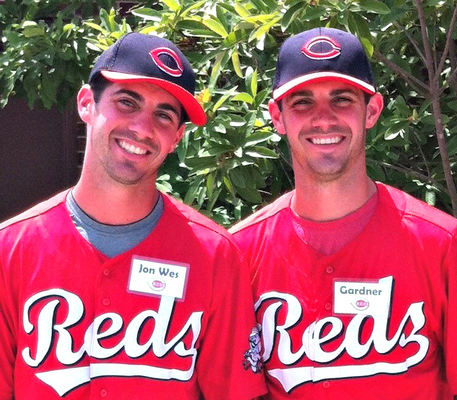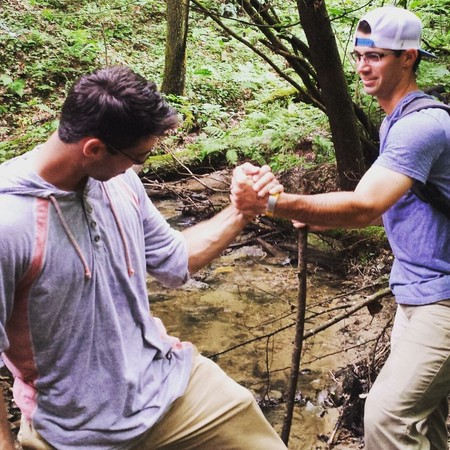Even starting with the fact they're identical twins, Jon Wes and Gardner Adams are incredibly alike.
At age 27, each could pass for the other. They are 5-foot-10, about 170 pounds, with dark hair and easy smiles. There are no scars or other giveaways to help tell them apart.
Both are fond of running, passionate about baseball and deeply devoted to Christianity.
If one is humming a song, there's a good chance the other is humming the same tune. It'll always be Christian music, perhaps Christian rap -- and never, ever country, despite being surrounded by it as lifelong residents of Lexington, Kentucky.
Their circle of friends overlaps so much, one could probably use the other's phone for an entire week without missing a phone number or email address. And their phones could get mixed up seeing as they work at the same place while both studying to become teachers and coaches.
Then there's the most important shared trait of all. Both their lives were saved by CPR.
It's an amazing story, one that started on June 28, 2014, and took another incredible turn on Aug. 15 of this year. It's my pleasure to share it with you now, just days after my organization, the American Heart Association, released updated CPR guidelines.
These standards for resuscitation come out every five years, so professional lifesavers everywhere take note when they are changed. To the average person, the latest refinements are quite minor; the basic advice remains that if you see an adult suddenly collapse, call 911 then push hard and fast on the center of their chest, preferably to the rhythm of the aptly named disco song "Stayin' Alive."
Saving one life is incredible. Saving two, like the Adams brothers, well, that's even more phenomenal.
***
The night that everything changed for this family began simply enough.
Gardner and his wife Mary Ann were going out to dinner, and they invited his parents, Bridget and Wesley, and his brothers -- Jon Wes and younger brother Dean.
Jon Wes normally would have been on the road. He worked baseball camps for the Cincinnati Reds, helping kids get better at hitting, fielding and throwing. There was no gig this particular week, and spent it re-evaluating his life.
He had a bachelor's degree and a master's degree in sports administration, but wasn't exactly climbing the ranks in a Major League Baseball team's front office or in college athletics. While his friends were launching careers and getting married, he felt like he was falling behind. Two days earlier, he'd taken a break during a run and made what he calls "a selfish prayer," asking for a sign that his faith wasn't in vain, that things would all work out for the best.
So Jon Wes turned down the dinner invitation, opting instead for another stress-relieving run at his favorite spot, the trail around the University of Kentucky Arboretum.
He usually took off going right, counterclockwise, as most races are run. For no reason, at 7:30 p.m. on this night, he went left.
Wearing a black T-shirt, black shorts and, underneath, a pair of baseball sliding shorts he rarely ran in, Jon Wes had covered 6.2 miles when he approached a concert. Young At Heart, a local bluegrass band, was performing for about 200 people.
"I crashed the concert -- literally," he said. "I sort of came rushing in like a linebacker. I took out three or four chairs. The band stopped playing immediately."
Jon Wes went down near two doctors and two nurses. They called 911, then began CPR, keeping it up for about 20 minutes until emergency medical technicians arrived. It took two shocks from a defibrillator to get his heart beating again. Disoriented, he began fighting the EMTs, so he was sedated for the ride to the University of Kentucky Hospital.
At the hospital, one of the challenges was figuring out his identity. He had no wallet, just a cell phone that provided no clues because of a passcode.
Then one of the ER nurses noticed a name scrawled on his sliding shorts. Another nurse recognized the name; just a few days earlier, she'd had an appointment with Bridget Adams, a nurse practitioner who loved telling patients about the exploits of her boys.
Soon, Jon Wes was whisked into the cardiac catheterization lab so doctors could learn more about his heart and why it had stopped.
***
Back at Bridget and Wesley's house after dinner, everyone was surprised Jon Wes wasn't there yet. So they went to find him.
They saw his car in the Arboretum parking lot. Gardner was headed toward a bench where Jon Wes sometimes went to people-watch or to read his Bible when he got a call from his dad. The hospital had called his mom, and they needed to get there right away.
"That's as fast as I've ever run in my life," Gardner said.
At the hospital, a doctor gave them a grim report.
"Right now, we're looking at a 30-percent chance of him living," the doctor said. "If he makes it, he might not be the same son and brother you knew before."
This prompted Gardner to think, "You don't know how stubborn my brother is."
***
Structurally, Jon Wes' heart looked great. That meant he had an electrical issue.
Only, what kind?
Unable to figure it out, and worried that whatever it was it might strike again, doctors implanted an implantable cardioverter defibrillator (ICD). The device monitors the heart and can shock it back into rhythm if it becomes abnormal.
He left the hospital on July 3, just five days after nearly dying. Whether it was his stubbornness or the fact he was otherwise a young, healthy athlete, Jon Wes had no lingering issues... well, except for the lack of a diagnosis.
Then doctors came up with a Plan B. They tested Gardner.
***
Gardner knew all about electrocardiograms (ECGs), a common exam to measure the electrical activity of the heart.
He'd had a heart murmur as a kid, and had plenty of exams because of that, with more coming as part of athletic physicals. His ECG results were always abnormal, so consistently -- and without anything else going wrong -- that abnormal became considered normal for him.
Now, the stakes were different.
During a stress test, doctors induced the abnormal rhythm, and this time had a name for it: Brugada syndrome, an often inherited heart rhythm disorder that wasn't even discovered until the early 1990s, when Jon Wes and Gardner were toddlers.
Jon Wes' diagnosis was soon confirmed, too. There was more good news: An ICD is the first line of defense, and he'd already received that.
But what about Gardner?
He had Brugada syndrome, but he'd never gone into cardiac arrest. Getting an ICD as preventive maintenance would be unusual, although in this case it made sense.
Gardner's surgeon was for it. His cardiologist wasn't convinced; he had no symptoms and it had taken medicines during a stress test to trigger any.
"What made me do it was looking into my wife's eyes and my mother's eyes and seeing them teary," Gardner said. "I wasn't going to let them worry about it."
So about two months after Jon Wes got his ICD implanted near his left pectoral muscle, Gardner got the same device in the same spot.
When Gardner awoke, his first words were, "Look, Mom, we're identical again!"
***
On a Saturday evening this past August, almost exactly a year since Gardner received his ICD, he and Mary Ann went to a park near their home.
Before the Brugada diagnosis, he ran by himself. Mary Ann has joined him ever since. Well, sort of. He runs in one direction and she walks in the other, their paths crossing often enough to let her keep an eye on him.
After only four minutes, Gardner slowed to a walk. His vision became cloudy. Although he'd never passed out, he knew it was about to happen.
He pulled out his phone to call Mary Ann. Her name was on the screen, but he collapsed before hitting the call button.
"I was only dead for about 20 or 30 seconds," he said. "The ICD sent a shock to my heart and brought me back."
Mary Ann came around a corner minutes later. She saw him bloodied and dirty from the fall, his skin ghostly white as passersby tended to him.
At the hospital, doctors said his heart rate had spiked to about 300 beats per minute. His heart quivered more than beat, keeping oxygen from getting to his brain, thus causing him to faint, until the ICD kicked in.
"When they told me that, I was crying and laughing," Gardner said. "I was thankful. I was told that might never happen and then it did."
This video was created by UK HealthCare prior to the cardiac event that triggered Gardner's ICD
***
Technically, Jon Wes was saved by CPR and Gardner was saved by his ICD.
That's not how the family sees it.
"If Jon Wes hadn't made it -- if there hadn't been people there to do CPR -- then he would've died and we wouldn't have known why," Gardner said. "We wouldn't have known that I have it, and I would've never gotten the ICD."
There are more layers, too.
Wesley and Dean have since been diagnosed with Brugada syndrome. Wesley received an ICD a few weeks ago. Dean's case is a bit different; he's still considering whether an ICD is his best choice.
As for Jon Wes, the questions he was facing before his incident that started all of this have cleared up.
He has a new girlfriend, and a new career path. It's the same as Gardner: becoming a high school teacher and baseball coach. He's also reaffirmed his faith.
"A lot of good has come from that day," Jon Wes said. "I appreciate life more and I'm thankful for every day. It opened my eyes and showed me I'm not invincible. I now live in the moment and enjoy what I have. I know it sounds like a cliché, but it's all true."
In addition to sharing the same heart condition and having matching ICDs, there are two more noteworthy things these guys have in common.
Both are CPR trained.
And both strongly encourage others to learn as well. That includes getting state legislators to make Kentucky among the states that require CPR training as a component for graduating high school.
"You never know whose life you can save one day," Gardner said.
"Maybe," Jon Wes added, "more than one person."



